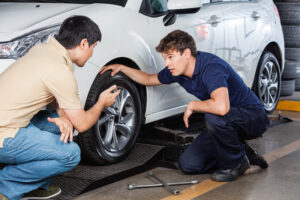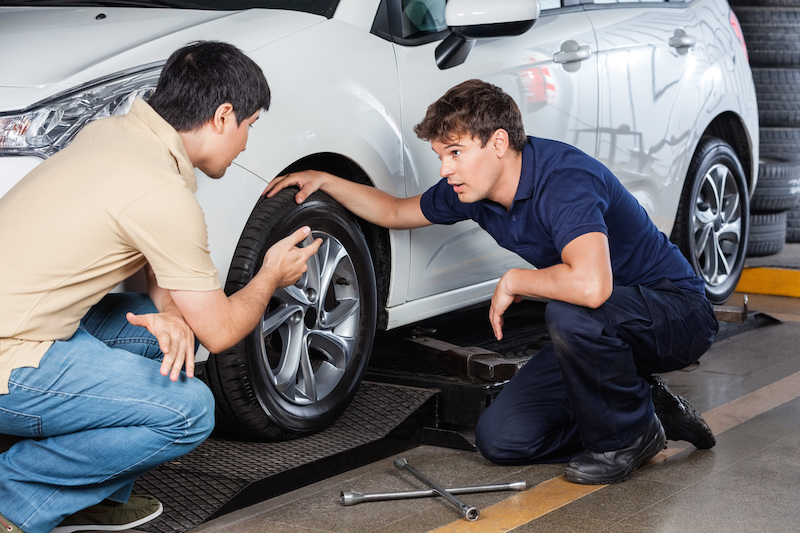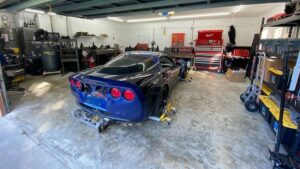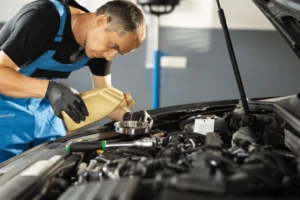Maintaining your car doesn’t need to be daunting – just a bit of your time will do, saving money while giving you a sense of achievement and achievement.

If your tires are low on air, head to a gas station to purchase an electronic tire pressure gauge – there are even foolproof versions! Additionally, an emergency spare and plug kit should also be purchased just in case.
Oil Change
Oil remains the backbone of car engines despite today’s increasingly complex designs, providing essential lubrication for parts, protecting from heat and pressure damage, as well as clearing away particles that would otherwise wreak havoc with them. Regular oil changes help your car operate more smoothly while increasing its longevity.
Oil changes can be done easily on your own without resorting to expensive tools or parts from an auto parts store, saving time and money over garage labor rates. Doing it yourself also offers potential cost savings compared to using professional services for this task.
Before opening the hood of your car, ensure it is cool and all oil has been drained off before proceeding. Tie back long hair and remove jewellery that could get caught on engine parts or scratch the hood; additionally consult your owner’s manual for specific instructions and warnings before jacking and resting your car on axle stands, according to what it states in your manual; next drain the old oil out and add fresh, clean lubricant from a reliable brand if required by its instructions; finally drain and replace with new, clean oil from brand branded lubricants which could help avoid future hassles during maintenance steps.
Spark Plugs
Spark plugs generate the tiny electrical spark necessary to ignite the air/fuel mixture in your engine’s combustion chamber at precisely the right moment and transform chemical energy into the kinetic energy needed for driving forward motion. Without spark plugs, engines would fail entirely.
Spark plugs are small metal rods equipped with threads at one end to connect directly with an ignition system, and another end featuring a metal hook designed to ground any spark emanating from their center electrode.
Most spark plugs are made from copper, as its conductivity and cost make it the obvious choice for most applications. However, for high-performance engines that demand maximum performance iridium or platinum spark plugs may offer superior conductivity and last nearly double as long.
Removing old spark plugs can reveal much about the health of your engine by inspecting their condition – particularly around their spark plug tips where sparks occur. There are even “readers,” which are like combined flashlights and magnifiers designed to make viewing spark plugs easier.
Tires
Your car’s tires play an essential role, from supporting its load to providing traction on the road surface. They also perform other important duties, including absorbing road shocks, shifting direction of travel and helping maintain safe driving speeds.
Regular inspections of your tire tread and sidewalls will allow you to detect problems like uneven wear, cuts, punctures, bulges or snags quickly and reliably. Should any be discovered, have them repaired immediately or consider replacement of your tire altogether.
To determine the size of your tires, look at both numbers before the slash on the sidewall, which are in two-digit format; one will indicate rim diameter in inches while the second gives width of tread that contacts road surface.
Select tires rated specifically for your car and climate if possible; choosing the appropriate tire can significantly enhance driving comfort and safety. Your door jamb or owner’s manual should contain the recommended tire pressure settings.
Brakes
Your car’s brake system works to slow and stop its motion by converting kinetic energy to thermal energy through friction between stationary pads and rotating wheels or drums, producing heat equivalent to boiling one liter of water in seven seconds, thus stopping its motion.
Your brake pads contain sacrificial friction material that wears away over time and needs replacing, creating fine dust particles which pollute the environment. Resurfacing or replacement may also be necessary if they become too thin for effective performance.
Except for pad replacement, most car brake systems are engineered to last under what the manufacturer considers normal operating conditions. Inspection can detect leaks and damage in deeper parts of your brake system–like the master cylinder–but leaks may remain beyond your reach as a do-it-yourselfer.
Maintain the proper function of your brakes by periodically monitoring their fluid levels. A baster can be used to quickly drain off dark brown brake fluid and pour it into a recycling bottle; then simply replace your reservoir cap and refill as instructed in your owner’s manual.
Lights
Are you curious to witness just how straightforward DIY car projects can be? To see just how straightforward DIY jobs can be, check out how simple changing a headlight on your model of car on YouTube can be. Procedures vary but generally involve removing covers, air boxes and/or bumpers in order to access the back of headlight unit and change out bulbs if necessary – most owners’ manuals provide information regarding different bulb sizes available to use when changing headlights.
An efficient lights system is essential to safety on the road and efficiency in general. Staying on top of maintenance by conducting regular visual walkaround inspections will save time, money, and help ensure that you remain as safe as possible on the road.



